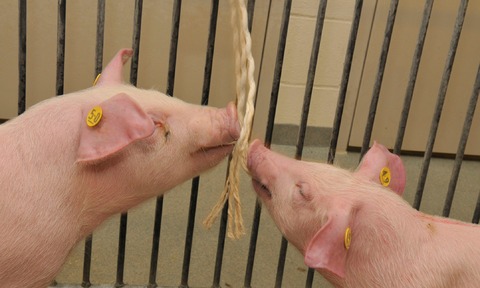
Study finds that pigs can be screened quickly for a range of common pathogens, such as PRRSV, SIV and PCV2, using a PCR-based test system.
The system uses samples of oral fluids which can be obtained quickly and easily by leaving a cotton rope in each pen for pigs to chew on.
After 20 minutes or so, the rope can be retrieved and the saliva and gingival crevicular fluid squeezed into a sample bag and represents a pooled sample from the group.
Recent studies by researchers from Iowa State University in the US, and biotechnology company Life Technologies, have demonstrated that oral fluid samples collected in this way can form the basis of a quick and cost-effective method for screening for a range of common viral pathogens.
The samples were tested using Applied Biosystems sample preparation and real-time PCR test products which are produced by Life Technologies. The system can isolate and identify viral nucleic acid in a matter of hours.
For PRRS, pooled samples of oral fluids were collected from groups of experimentally infected pigs using the rope technique, along with serum samples from each individual pig on the same days.
Both serum samples and oral fluids were processed using the same MagMAX preparation system and TaqMan real-time PCR test.
The results showed that PRRSV nucleic acid was detectable in both serum and oral fluid samples from the day of infection through to 40 days after infection.
For PCV2, 24 pigs that were free of PRRSV and SIV were divided into 4 pens in separate rooms, and challenged with two different virus strains (PCV2a and PVC2b) at different times. One pen acted as a (non-challenged) control.
Oral fluids were collected regularly up to 140 days after initial challenge and tested using real-time PCR. High titres of PCV2 were detected from day 12 to day 28 post infection and virus was detectable throughout the entire testing period (days 2 to 98).
For SIV, a total of 180 spiked oral fluid samples were tested using real-time PCR, and subtyping reagents were also used to identify haemagglutinin and neuraminidase subtypes. The results showed that SIV nucleic acid was detectable in oral fluid samples spiked with high, medium and low copy numbers of SIV, and all positive samples could be successfully sub-typed.
“These results show that the simplicity of oral fluid sampling, combined with the speed and sensitivity of a PCR-based system, provides a practical and cost-effective way of monitoring large numbers of pigs for common virus pathogens,” said Christina Boss, European Professional Service Veterinarian for LifeTechnologies.
Screening for PRRS using samples of oral fluids has been gaining popularity over recent years because large numbers of pigs can be tested without increased cost or labour. The new research is due to be presented as a poster at the ESPHM meeting in Bruges in April.




